M
mtl-huntr
Guest
Making a Sand / Gravel Scoop
One of the first places I took my new metal detector was a playground at a school. As I drove up I had my eye on the gravel playground area where the slides, swings and monkey bars are located. Thinking this would be easy digging I unloaded my detector and various digging utensils and started out to find my treasure.? I soon realized that digging in playground gravel is relatively easy, finding the treasure is more difficult. The gravel is loose and moves around a lot making it easy to loose your prize. Unlike dirt you can?t dig a plug waive it in front of the coil and determine if you captured your treasure.? I quickly found myself back in the grassy area digging in the dirt.
I kept thinking of that gravel area, I know lots of coins and jewelry must have been lost there but how can I effectively work that area? Well after visiting my local metal detector shop, looking at all their tools I noticed a sand scoop.? I?m thinking this should work nicely but only two problems. Number one the scoop cost $19.95 and two the scoop is? made of metal. I would think a good heavy plastic would be better so you could scan your loaded scoop to see if you got the treasure or not.? I looked the scoop over and start thinking of a way to make my own.
Off to the local thrift store. I start down the isles looking for anything that might work, then I see it, a Tupperware pitcher about 6 inches tall and 5 inches in diameter with a heavy sturdy handle this is perfect and the best part is its only .49 cents.
Now how to make it?? A few questions have to be answered first.
1.? ?What size should I drill the holes.
2.? ?How many holes can I drill without destroying the integrity of the scoop?
3.? ?Placement of the holes so the gravel will easily fall out leaving the prize.
The holes must be large enough for the gravel to fall out easily and small enough to hold a ring or a dime. After looking though my drills I determine a 5/8 wood bit is about the right size. The pictures I have included show my first attempt at my low cost sand and gravel scoop. Placement of the holes and the number of holes will be determined by the type of scoop you find.
Field Test: As soon as I finished it I went out just before dark for about 45 minutes. When I got a signal I would fill my scoop then waive it in front of my coil to see if I got it, if not just dump the contents and try again. When I have determined that the treasure is in the scoop then just shake the gravel down through the holes in the bottom when the gravel is gone your prize should appear. On my first time out I found a Kennedy Half, Lincoln Memorial Cent, a bobby pin and a small screw and other trash. Not bad for my first try, I can?t wait to get back out there. Better yet can't wait to go to the beach!!!
One of the first places I took my new metal detector was a playground at a school. As I drove up I had my eye on the gravel playground area where the slides, swings and monkey bars are located. Thinking this would be easy digging I unloaded my detector and various digging utensils and started out to find my treasure.? I soon realized that digging in playground gravel is relatively easy, finding the treasure is more difficult. The gravel is loose and moves around a lot making it easy to loose your prize. Unlike dirt you can?t dig a plug waive it in front of the coil and determine if you captured your treasure.? I quickly found myself back in the grassy area digging in the dirt.
I kept thinking of that gravel area, I know lots of coins and jewelry must have been lost there but how can I effectively work that area? Well after visiting my local metal detector shop, looking at all their tools I noticed a sand scoop.? I?m thinking this should work nicely but only two problems. Number one the scoop cost $19.95 and two the scoop is? made of metal. I would think a good heavy plastic would be better so you could scan your loaded scoop to see if you got the treasure or not.? I looked the scoop over and start thinking of a way to make my own.
Off to the local thrift store. I start down the isles looking for anything that might work, then I see it, a Tupperware pitcher about 6 inches tall and 5 inches in diameter with a heavy sturdy handle this is perfect and the best part is its only .49 cents.
Now how to make it?? A few questions have to be answered first.
1.? ?What size should I drill the holes.
2.? ?How many holes can I drill without destroying the integrity of the scoop?
3.? ?Placement of the holes so the gravel will easily fall out leaving the prize.
The holes must be large enough for the gravel to fall out easily and small enough to hold a ring or a dime. After looking though my drills I determine a 5/8 wood bit is about the right size. The pictures I have included show my first attempt at my low cost sand and gravel scoop. Placement of the holes and the number of holes will be determined by the type of scoop you find.
Field Test: As soon as I finished it I went out just before dark for about 45 minutes. When I got a signal I would fill my scoop then waive it in front of my coil to see if I got it, if not just dump the contents and try again. When I have determined that the treasure is in the scoop then just shake the gravel down through the holes in the bottom when the gravel is gone your prize should appear. On my first time out I found a Kennedy Half, Lincoln Memorial Cent, a bobby pin and a small screw and other trash. Not bad for my first try, I can?t wait to get back out there. Better yet can't wait to go to the beach!!!
Amazon Forum Fav 👍
Attachments
Upvote
0


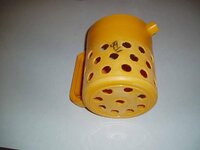
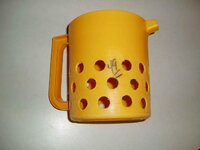
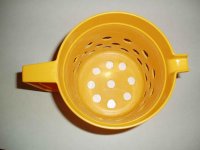
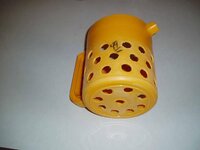
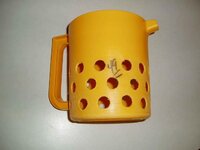
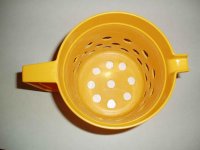
 tight on $$ right now lol
tight on $$ right now lol 



